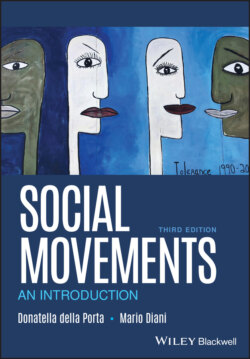Читать книгу Social Movements - Donatella della Porta - Страница 5
ОглавлениеForeword to the Third Edition
This is the third edition of a book that was first published in English in 1999 (the Italian edition having appeared in 1997 with the Nuova Italia Scientifica publishing press), and then in 2006. Innumerable significant changes have taken place in the political landscape over the last decades – think of the 2011 revolts across the globe, the spread of online protest activity, or the renaissance of right‐wing extremism. They have been paralleled by a constant growth of research on social movements and collective action, as witnessed by the proliferation of handbooks charting the field from multiple angles, specialized journals, or references to social movement theory in the scientific literature. Both developments have shaped the drafting of the third edition. On the one hand, we have updated many of our empirical examples, including references to recent episodes of contention and trying to add more materials from a comparative angle. We have also kept, however, many references to earlier movements, as we deem important to draw our readers’ attention to the fact that some basic, core mechanisms of collective action may be found operating across movements that may differ substantially in timing and content. As for our treatment of the literature, given its fast and massive increase, it is even more selective and partial than in the previous two editions. Back in the late 1990s, the first edition of the book also served as a “literature review” of sort, bringing together, as the late Charles Tilly noted, European and American perspectives in the same introductory text. In this new edition, performing a similar mapping function would have been neither feasible, given the exponential rise in the scientific output, nor necessary, as a number of systematic accounts of growth in the field have appeared. As we have promoted some of them (della Porta 2014; della Porta and Diani 2015) and contributed to others (e.g. Fillieule and Accornero 2016; Snow et al. 2019), we know that they can do a much better job at covering the field than we could in this book. Accordingly, this edition presents itself even more neatly as an introductory text, if not one for beginners in social research.
It is also worth reminding readers that they are not being introduced to the full range of possible intellectual approaches to the theme “social movements.” Significant contributions have come from fields such as history, political philosophy, anthropology, or psychology, that are almost entirely neglected here. So are important treatments of social movements by “social theory” broadly conceived (on that see Crossley 2002; Buechler 2011; Cox and Fominaya 2013; Eder 2015). The approach we refer to has established itself mainly at the intersection of sociology and political science, with the ambition of generating theory‐driven systematic empirical research. For all its limitations, and despite an empirical focus that is still primarily Western centric, the conceptual apparatus introduced in this book has also proved a useful tool for many researchers investigating other areas of the world (Ellis and van Kessel 2009; Broadbent and Brockman 2011; Rossi and von Bülow 2015). Ours may not be (it certainly is not) the whole story, but it is an important story. We are delighted to be able to share its third version with our readers.
Florence and Trento, May 2019
ACKNOWLEDGMENTS
We are grateful to our editors at Blackwell for their patience and assistance, to Daniela Chironi for her careful work on the bibliography, and to Cambridge University Press for granting permission to reproduce Figure 6.1 and some sections of Chapter 6 from Diani (2015).
